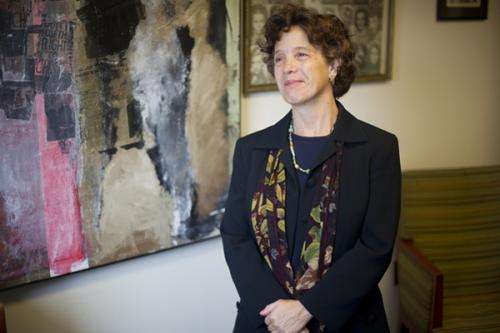3Qs: Examining the changing nature of marriage

A recent report from the Pew Research Center highlighted that 4.2 million adults were newly married in 2011, which is a decline from the 4.5 million newlyweds estimated in 2008. The estimates come from the Census Bureau's American Community Survey, which began asking respondents in 2008 whether they had been married, divorced or widowed in the previous 12 months. Here, Suzanna Walters, professor of sociology and director of Women's, Gender and Sexuality Studies Program, suggests possible reasons for fewer Americans marrying.
Barely half (51 percent) of American adults were married in 2011, according to the report data, compared with 72 percent in 1960. What might account for this decline, and what factors should be considered when determining whether the institution of marriage has changed over time?
When there is panic in the press or among politicians about marriage changing, we need to take a deep breath and remember that marriage is always evolving. For instance, the 72 percent of married Americans in 1960 represents a post-war marriage boom. Twenty years before that, marriage rates for college-educated women were strikingly low. Marriage rates have and always will fluctuate.
It is also important to note that the institution of marriage has never been stable in the way that is has been ideologically imagined. Historically, we've seen marriage go from something that once only propertied classes practiced, to a much more democratic affair—from polygamous to dyadic; from arranged to companionate. Nevertheless, marriage has been built on an edifice of discrimination that enforced a heterosexual norm as the only route to marital legality. While this is changing, the federal Defense of Marriage Act remains in place and same-sex marriage is illegal across the majority of the United States.
Lastly, we must also consider that for women specifically, marriage has shifted from outright ownership and coverture, to the more "benign" inequities of the double shift—where women are expected to be equal wage earners but also to take the lion's share of domestic responsibilities and tasks.
Marriage rates fell from 2008 to 2011 among all age and education groups, but particularly for less-educated Americans. What do you make of the connection between education level and marriage, and has this connection also evolved over the years?
In many ways, educational attainment in the U.S. is a stand-in for economic class. Marriage has so much to do with property relationship even if it is also about love, or at least a discourse of romantic attachment. People with less property—or few hopes of greater attainment in their lifetimes because of lower levels of education—are less likely to find marriage to be a compelling contract in which to enter.
It is not that people with less education—and therefore lower socioeconomic class status—necessarily have a lower regard for marriage as an institution. Rather, there is a sort of conflict between the expectations we have of marriage, such as homeownership, and the declining economic prospects of workers who are not college educated. If we believe that entering into marriage is predicated on being able to own a home, pay the bills, have a stable job and participate in our consumerist economy, then many less-educated Americans simply can't meet that bar. This is particularly true in times of economic recession or depression. In other words, if being a "breadwinner" is part of the marriage equation, then it is surely less salient as an institution for those economically more bereft, either due to educational levels, racial inequalities or class stratification.
Will the decline of marriage have an effect on family life?
We shouldn't confuse "marriage" with "family." Lots of people get married, but many of them get divorced as well. Although divorce rates have declined in recent years, data shows that four out of 10 marriages still end in divorce. What this means is that only a small number of families are "nuclear"—meaning two parents and kids. At its height, the nuclear family only accounted for about 40 percent of American families, and now it accounts for about 20 percent of them—including stepfamilies. For decades now, most American families have been constructed outside or between marriages.
In fact, I would argue that the decline of marriage as a signifier of adulthood, citizenship and social belonging is actually a good thing. Valuing families of choice, individual sexual liberty and alternative forms of constructing kinship can open up our imaginations to creative new patterns of care and intimacy. To the extent that marriage is dethroned as the access point for such social resources as healthcare and retirement benefits—as well as citizenship—our society will all better off.
Provided by Northeastern University



















